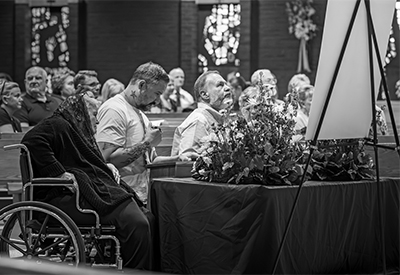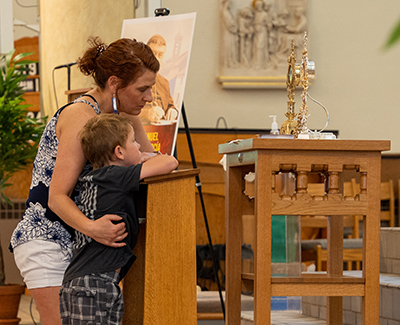
A UNIQUELY CATHOLIC DEVOTION
by Vince Dragone
08/17/2023
St. Manuel González García, who has come to be known as the Bishop of the Abandoned Tabernacle, adopted a divine mandate to love and serve Jesus on behalf of a town that didn't. His life was a testament to drawing strength from the Eucharist, providing an example of faith during modern disbelief.
Blessed Carlo Acutis, the first millennial to be beatified, became known for his digital evangelization, cataloging Eucharistic miracles, which continues to make an indelible imprint on the global Catholic community. His passion radiated the presence of Christ in the Eucharist, reflecting a deep devotion shared by these holy figures.
The Diocese of Erie was among 39 dioceses and organizations in the United States privileged to host the relics of these two men whose understanding of and passion for the Eucharist inspired hundreds of Catholics in the Diocese of Erie during their 10-day pilgrimage in May. This was a spiritual voyage that englighted hearts and knitted communities closer to the true presence of Christ in the Eucharist. As the sacred relics journeyed across different locations, the unifying power of faith was strikingly evident. Parishes within the diocese embraced a level of unity and cooperation, using social media platforms to effectively communicate the relics' schedule to as many people as possible. Simultaneously, they seized this opportunity to educate parishioners about the lives of St. Manuel and Blessed Carlo, focusing on their remarkable contributions and the fact that they lived their lives pointing to Christ. These teachings were incorporated into homilies, not only enriching the knowledge of the parishioners but also fostering a deeper understanding of the sanctity of the Eucharist. It was an unparalleled period of communal spiritual education and shared excitement that underscored the beauty of collective faith.
As the sacred relics journeyed across different locations, the unifying power of faith was strikingly evident. Parishes within the diocese embraced a level of unity and cooperation, using social media platforms to effectively communicate the relics' schedule to as many people as possible. Simultaneously, they seized this opportunity to educate parishioners about the lives of St. Manuel and Blessed Carlo, focusing on their remarkable contributions and the fact that they lived their lives pointing to Christ. These teachings were incorporated into homilies, not only enriching the knowledge of the parishioners but also fostering a deeper understanding of the sanctity of the Eucharist. It was an unparalleled period of communal spiritual education and shared excitement that underscored the beauty of collective faith.
Central to this spiritual journey was the director of the diocesan Office for Divine Worship, Father Matt Kujawinski, who, along with Coordinator Maripat Grant, shaped the pilgrimage across the diocese.
“As many people know, we're in the midst of the Eucharistic Revival as a process of reinvigorating devotion to the Eucharist so that it can bear fruit in our lives by what we do. Blessed Carlo has been named one of the patrons of that process, and his relics were made available to the United States Conference of Catholic Bishops for the purpose of the revival,” says Father Matt.
Father Matt traveled to Syracuse, New York, where he received the relics which had just been in Manchester, New Hampshire. On the day they arrived, Bishop Lawrence Persico offered a private Mass for the families and friends of employees of St. Mark Catholic Center, during which he officially accepted the relics from the hands of children and teenagers in a beautiful testament to faith being passed down through generations.
“As we began to craft the schedule and plan the celebrations, we felt it was necessary and important to keep our young people in mind. So, when the relics were received by the bishop, we decided to ask children to be the ones who would present them to the bishop at the Mass that began this whole celebration,” he says.
As the relics traveled through the diocese, they inspired touching moments of faith. This was especially true for Dr. Jaci Phillips-Sabol, who regularly delivers presentations on Eucharistic miracles. These miracles, cataloged online by Blessed Carlo, have a scientific basis that Jaci is passionate about discussing.
“Three years ago, when I started these talks, I dedicated them to Blessed Carlo. At the time, people weren't even really talking about him. Now, his relics are here. It's a part of his actual heart, just like Jesus's heart is in these Eucharistic miracles. I feel like I share the platform with Blessed Carlo whenever I give this talk. But this time, I felt that in a more powerful, palpable sense. It was an incredible experience to give this presentation with his relics here and to venerate them," says Jaci.
Veneration of relics, as explained by Father Matt, is more than an act of respect; it is a connection with the holy lives of the saints and their teachings.
“Finding value in relics stems from the days of the persecution of the Christians in Rome where early Christians hid in the cemeteries and celebrated Mass on the tombs of the martyrs,” he says. “It then became custom to make sure that the relics of martyrs were in the altars where Mass was celebrated. And so, the idea of venerating and being physically close to the saints has been with us since the first days of the church.”
The relics stirred the faithful for various personal reasons. Lou Serafini of Erie, for instance, sought a deeper relationship with Christ in the Eucharist. “St. Manuel and Blessed Carlo had such a strong devotion to the Eucharist. If I could only have a small piece of that, I’d be OK with it,” Lou explained. "When I knelt before the relics, I felt a warm feeling in my heart. To me, it's like Jesus holding my heart. That's what he wants. It's hard to explain, but it really is the power of the Eucharist. It's Christ's body there. It gives me a deeper connection with my faith," he said.
“St. Manuel and Blessed Carlo had such a strong devotion to the Eucharist. If I could only have a small piece of that, I’d be OK with it,” Lou explained. "When I knelt before the relics, I felt a warm feeling in my heart. To me, it's like Jesus holding my heart. That's what he wants. It's hard to explain, but it really is the power of the Eucharist. It's Christ's body there. It gives me a deeper connection with my faith," he said.
The relics also served as symbols of hope and healing. Beverly Vento, of Erie, experienced in the world of relics, was among the many who sought solace and healing through her veneration.
"Relics have a powerful resonance that I've seen in action multiple times. One instance that comes to mind is when a woman collapsed during a choir session. I placed a prayer card that had been touched to one of St. Faustina’s relics on her, and she revived immediately. On another occasion, my aunt was suffering from total kidney failure. I prayed for her using a Lady of Fatima statue containing the relics of saints Jacinta and Francisco Marto. Her health was restored. These experiences have only reinforced my faith in the power and importance of these holy relics," Beverly explains.
The arrival of the relics at St. Stephen of Hungary Parish in Erie for a bilingual Spanish Mass painted a picture of faith's universality. Deacon Miguel Alvarez illustrated the relevance of the saints in his homily. Stressing that they are always ready to pray for us, he encouraged the congregation to draw strength from their intercession. Deacon Miguel's homily not only testified to his own faith but also highlighted the invaluable spiritual support saints provide in Catholic life.
After Mass, Deacon Miguel shared that his prayer to St. Manuel and Blessed Carlo was to be able to continue his ministry.
“I’ve been a deacon for 29 years, and without God’s help, it wouldn’t have been possible,” he says. “I asked them to pray for me that I may continue my work to serve God and to help those in need.”
The pilgrimage also played a significant role in Catholic schools, introducing students to the lives of Blessed Carlo and St. Manuel and, for some, providing their very first interaction with relics.
Father Matt says, “Blessed Carlo Acutis, being young, drew his mother back to faith. And young people can do that too. They have a lot to offer, and we have to keep that in mind. We sometimes forget when doing the work of ministry that young voices have insight too.”
Rayn, a junior at Mercyhurst Preparatory School, was inspired by Blessed Carlo’s use of technology to evangelize. “You can really express yourself and what you believe in. It just shows how crucial it is in today’s age that even a blessed or a saint could use the same tech as we do, enjoy it, and use it to spread our faith,” she said.
Cathy Dornisch of St. Marys was overjoyed by the presence of the relics for the students at Elk County Catholic High School. She said that she has three children in the school and constantly seeks Blessed Carlo’s intercession for them.
“It was overwhelming having those relics here at Mass,” Cathy shared as she wiped a tear from her eye.
This pilgrimage was an enlightening journey of faith, deeply connecting the community with the teachings of Christ in the Eucharist.
In his homily at Elk County Catholic School in St. Marys, Deacon Luke Daghir drew parallels between St. Peter's journey of faith and the short but impactful life of Blessed Carlo Acutis. He referred to Blessed Carlo as a ‘modern Peter,’ a model for students to navigate their own spiritual paths.
Deacon Luke painted a vivid picture of St. Peter, the fisherman who stumbled and faltered but kept coming back to his faith, becoming the 'rock' of the church. He likened this to Blessed Carlo, a young man deeply in love with the Eucharist who turned to his faith even when faced with terminal leukemia. He argued that, like Peter, Blessed Carlo showed that it was possible to stay steadfast in faith despite life's ups and downs.
Deacon Luke ended his homily with a simple, powerful challenge for the students: to follow the path of Blessed Carlo, a 'modern Peter,' who allowed Jesus to guide him. In doing so, he reminded them of the importance of staying close to Jesus.
Bonnie Housler from St. Marys visited the relics at Elk County Catholic School. She firmly believes in the importance of the Eucharist but also sees the value in venerating relics. She said that while the Eucharist is essential, venerating relics provides an opportunity to receive special graces. Her prayers during this event were primarily focused on her family. Specifically, she prayed for vocations to the priesthood within her family. It’s something she and her husband have been praying for 43 years.
The relics may have moved on from the diocese and will soon leave the United States as other countries across the globe eagerly await their turn. Their profound impact will endure not only in the hearts of those they touched, but also by anyone who feels drawn to read more about them and to pray for their intercession.
Blessed Carlo, pray for us.
St. Manuel, pray for us.
-
